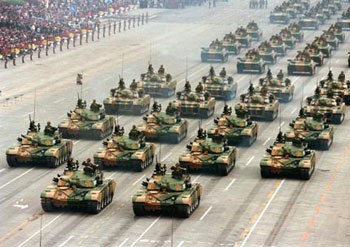International Affairs
 |
 |
 |
 |
 |
 |
 |
Pentagon: Military Losing Technological
Superiority to China
During the first Gulf War in the early 1990s, the U.S. military used a new generation of technological weapons that left the rest of the world far behind. But according the Frank Kendall, the Pentagon's under-secretary of defense for acquisitions, technology, and logistics, that advantage is evaporating.
 Speaking at a breakfast at the Navy League in Arlington, Virginia on Wednesday [November 5, 2014], Kendall said the deterioration has continued during his four and a half years on the job, "in large part because of our budget situation," including sequestration. Claudette Roulo of DoD News reported on the under-secretary's breakfast remarks:
Speaking at a breakfast at the Navy League in Arlington, Virginia on Wednesday [November 5, 2014], Kendall said the deterioration has continued during his four and a half years on the job, "in large part because of our budget situation," including sequestration. Claudette Roulo of DoD News reported on the under-secretary's breakfast remarks:
“When I talk to people on the Hill and I mention that I'm concerned about technological superiority … I get a reaction that is a sort of surprise, first of all, and disbelief. … I think we have gotten so accustomed to our technological superiority militarily that it's just a given, and it's one of the things I kind of fight against when I try to have these conversations,” Kendall said.
While the U.S. military's budget is being cut, China's budget has been growing at about 12 % annually, Kendall said, and may soon be as large as the U.S.'s. China is of particular concern according to the under-secretary because "no one's studied us more – including immediately after the first Gulf War – than the Chinese. And they have been building systems since then designed to counteract some of the things that we have."
Kendall is not concerned about war with China, but a stronger military will give that country proportionally more influence in the region. Additionally, the Chinese may sell their technology to other countries that the U.S. might end up facing someday in an armed conflict, and this also poses a problem. Again, DoD News reports:
“The United States tends to rely on a small number of very expensive, but very capable assets, the under-secretary said, and that makes the military vulnerable once an enemy learns how to attack those assets, noting that no one has a monopoly on technology, war-fighting power or doctrinal and operational concepts.”
In October, Bill Gertz of the Washington Free Beacon reported on a draft of the annual report of the congressional, bipartisan U.S.-China Economic and Security Review Commission that seems to confirm and even expand on Kendall's concerns:
 “China’s rapid military modernization is altering the military balance of power in the Asia Pacific in ways that could engender destabilizing security competition between other major nearby countries, such as Japan and India, and exacerbate regional hot-spots such as Taiwan, the Korean Peninsula, the East China Sea and the South China Sea,” the report concludes in a section on military developments.
“China’s rapid military modernization is altering the military balance of power in the Asia Pacific in ways that could engender destabilizing security competition between other major nearby countries, such as Japan and India, and exacerbate regional hot-spots such as Taiwan, the Korean Peninsula, the East China Sea and the South China Sea,” the report concludes in a section on military developments.
Accusations of cyber-espionage by the Chinese in recent years have also heightened the concerns about China's ability to keep up with U.S. technology and design systems to counteract it. While Kendall did not address espionage by the Chinese, he said that strategic investments in technology by China are targeted at changing the balance of power in Asia:
“They're designed to present us with a very difficult problem if we want to operate in the vicinity of China,” he added. “And it's structured in a way that they can, perhaps, control escalation, so they can force us to back down.”
Overall, as the one in charge of acquisition the U.S. military's technological assets, Kendall does not seem optimistic: "I'm worried about whether we're keeping up or not."

Jeryl Bier first published this article
in The Weekly Standard on November 6, 2014

Pentagon official Frank Kendall warns about China's growing technical & military superiority
“When I talk to people on the Hill and I mention that I'm concerned about technological superiority … I get a reaction that is a sort of surprise, first of all, and disbelief. … I think we have gotten so accustomed to our technological superiority militarily that it's just a given, and it's one of the things I kind of fight against when I try to have these conversations,” Kendall said.
While the U.S. military's budget is being cut, China's budget has been growing at about 12 % annually, Kendall said, and may soon be as large as the U.S.'s. China is of particular concern according to the under-secretary because "no one's studied us more – including immediately after the first Gulf War – than the Chinese. And they have been building systems since then designed to counteract some of the things that we have."
Kendall is not concerned about war with China, but a stronger military will give that country proportionally more influence in the region. Additionally, the Chinese may sell their technology to other countries that the U.S. might end up facing someday in an armed conflict, and this also poses a problem. Again, DoD News reports:
“The United States tends to rely on a small number of very expensive, but very capable assets, the under-secretary said, and that makes the military vulnerable once an enemy learns how to attack those assets, noting that no one has a monopoly on technology, war-fighting power or doctrinal and operational concepts.”
In October, Bill Gertz of the Washington Free Beacon reported on a draft of the annual report of the congressional, bipartisan U.S.-China Economic and Security Review Commission that seems to confirm and even expand on Kendall's concerns:

China's military spending continues to swell each year
Accusations of cyber-espionage by the Chinese in recent years have also heightened the concerns about China's ability to keep up with U.S. technology and design systems to counteract it. While Kendall did not address espionage by the Chinese, he said that strategic investments in technology by China are targeted at changing the balance of power in Asia:
“They're designed to present us with a very difficult problem if we want to operate in the vicinity of China,” he added. “And it's structured in a way that they can, perhaps, control escalation, so they can force us to back down.”
Overall, as the one in charge of acquisition the U.S. military's technological assets, Kendall does not seem optimistic: "I'm worried about whether we're keeping up or not."

in The Weekly Standard on November 6, 2014
Posted November 12, 2014
______________________
______________________











